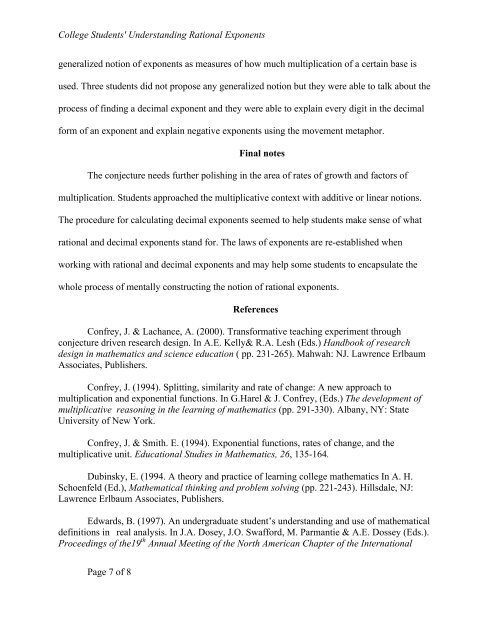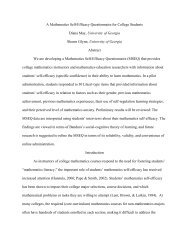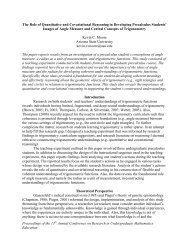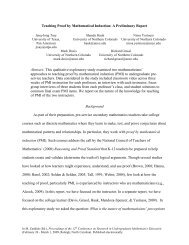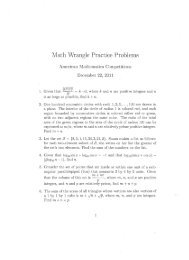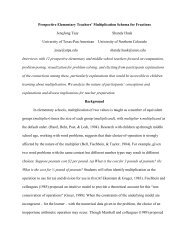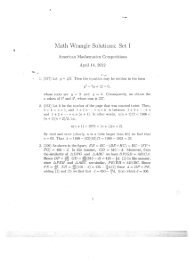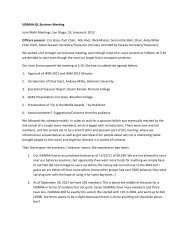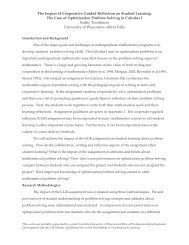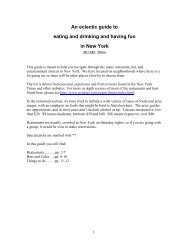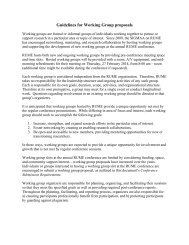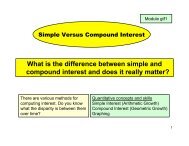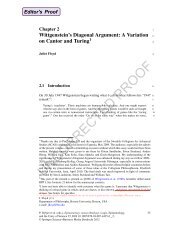Understanding of Rational Exponents - Mathematical Association of ...
Understanding of Rational Exponents - Mathematical Association of ...
Understanding of Rational Exponents - Mathematical Association of ...
Create successful ePaper yourself
Turn your PDF publications into a flip-book with our unique Google optimized e-Paper software.
College Students' <strong>Understanding</strong> <strong>Rational</strong> <strong>Exponents</strong>generalized notion <strong>of</strong> exponents as measures <strong>of</strong> how much multiplication <strong>of</strong> a certain base isused. Three students did not propose any generalized notion but they were able to talk about theprocess <strong>of</strong> finding a decimal exponent and they were able to explain every digit in the decimalform <strong>of</strong> an exponent and explain negative exponents using the movement metaphor.Final notesThe conjecture needs further polishing in the area <strong>of</strong> rates <strong>of</strong> growth and factors <strong>of</strong>multiplication. Students approached the multiplicative context with additive or linear notions.The procedure for calculating decimal exponents seemed to help students make sense <strong>of</strong> whatrational and decimal exponents stand for. The laws <strong>of</strong> exponents are re-established whenworking with rational and decimal exponents and may help some students to encapsulate thewhole process <strong>of</strong> mentally constructing the notion <strong>of</strong> rational exponents.ReferencesConfrey, J. & Lachance, A. (2000). Transformative teaching experiment throughconjecture driven research design. In A.E. Kelly& R.A. Lesh (Eds.) Handbook <strong>of</strong> researchdesign in mathematics and science education ( pp. 231-265). Mahwah: NJ. Lawrence ErlbaumAssociates, Publishers.Confrey, J. (1994). Splitting, similarity and rate <strong>of</strong> change: A new approach tomultiplication and exponential functions. In G.Harel & J. Confrey, (Eds.) The development <strong>of</strong>multiplicative reasoning in the learning <strong>of</strong> mathematics (pp. 291-330). Albany, NY: StateUniversity <strong>of</strong> New York.Confrey, J. & Smith. E. (1994). Exponential functions, rates <strong>of</strong> change, and themultiplicative unit. Educational Studies in Mathematics, 26, 135-164.Dubinsky, E. (1994. A theory and practice <strong>of</strong> learning college mathematics In A. H.Schoenfeld (Ed.), <strong>Mathematical</strong> thinking and problem solving (pp. 221-243). Hillsdale, NJ:Lawrence Erlbaum Associates, Publishers.Edwards, B. (1997). An undergraduate student’s understanding and use <strong>of</strong> mathematicaldefinitions in real analysis. In J.A. Dosey, J.O. Swafford, M. Parmantie & A.E. Dossey (Eds.).Proceedings <strong>of</strong> the19 th Annual Meeting <strong>of</strong> the North American Chapter <strong>of</strong> the InternationalPage 7 <strong>of</strong> 8


